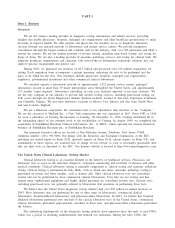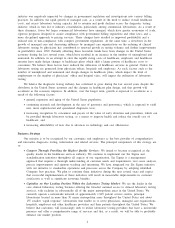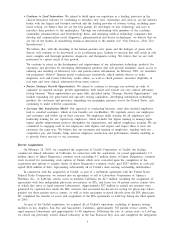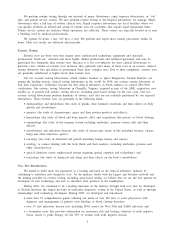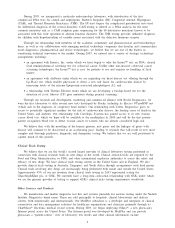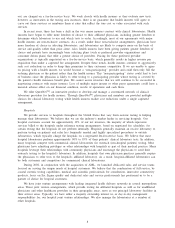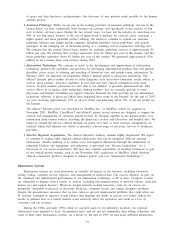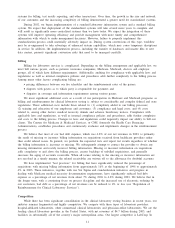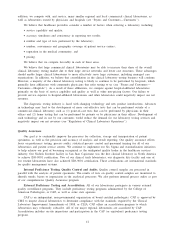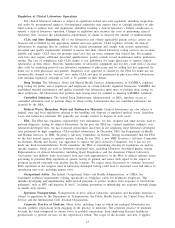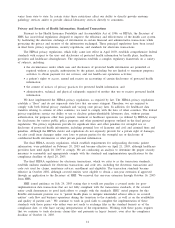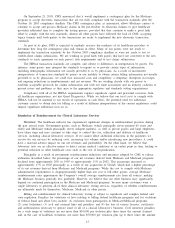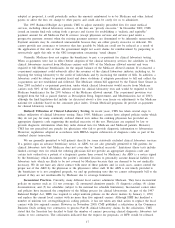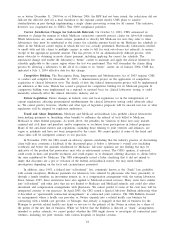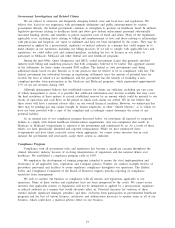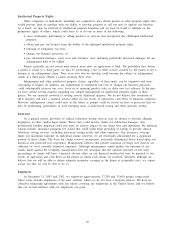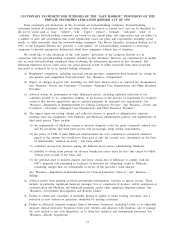Quest Diagnostics 2003 Annual Report Download - page 28
Download and view the complete annual report
Please find page 28 of the 2003 Quest Diagnostics annual report below. You can navigate through the pages in the report by either clicking on the pages listed below, or by using the keyword search tool below to find specific information within the annual report.systems for billing, test results reporting, and other transactions. Over time, the growth in the size and network
of our customers and the increasing complexity of billing demonstrated a greater need for standardized systems.
During 2002, we began implementation of a standard laboratory information system and a standard billing
system. We expect that deployment of the standardized systems will take several more years to complete and
will result in significantly more centralized systems than we have today. We expect the integration of these
systems will improve operating efficiency and provide management with more timely and comprehensive
information with which to make management decisions. However, failure to properly implement this
standardization process could materially adversely impact us. During system conversions of this type, workflow
may be re-engineered to take advantage of enhanced system capabilities, which may cause temporary disruptions
in service. In addition, the implementation process, including the transfer of databases and master files to new
data centers, presents significant conversion risks that need to be managed carefully.
Billing
Billing for laboratory services is complicated. Depending on the billing arrangement and applicable law, we
must bill various payers, such as patients, insurance companies, Medicare, Medicaid, doctors and employer
groups, all of which have different requirements. Additionally, auditing for compliance with applicable laws and
regulations as well as internal compliance policies and procedures adds further complexity to the billing process.
Among many other factors complicating billing are:
•pricing differences between our fee schedules and the reimbursement rates of the payers;
•disputes with payers as to which party is responsible for payment; and
•disparity in coverage and information requirements among various payers.
We incur significant additional costs as a result of our participation in Medicare and Medicaid programs, as
billing and reimbursement for clinical laboratory testing is subject to considerable and complex federal and state
regulations. These additional costs include those related to: (1) complexity added to our billing processes;
(2) training and education of our employees and customers; (3) compliance and legal costs; and (4) costs
related to, among other factors, medical necessity denials and advance beneficiary notices. Compliance with
applicable laws and regulations, as well as internal compliance policies and procedures, adds further complexity
and costs to the billing process. Changes in laws and regulations could negatively impact our ability to bill our
clients. The Centers for Medicare & Medicaid Services, or CMS (formerly the Health Care Financing
Administration), establishes procedures and continuously evaluates and implements changes in the reimbursement
process.
We believe that most of our bad debt expense, which was 4.8% of our net revenues in 2003, is primarily
the result of missing or incorrect billing information on requisitions received from healthcare providers rather
than credit related issues. In general, we perform the requested tests and report test results regardless of whether
the billing information is incorrect or missing. We subsequently attempt to contact the provider to obtain any
missing information and rectify incorrect billing information. Missing or incorrect information on requisitions
adds complexity to and slows the billing process, creates backlogs of unbilled requisitions, and generally
increases the aging of accounts receivable. When all issues relating to the missing or incorrect information are
not resolved in a timely manner, the related receivables are written off to the allowance for doubtful accounts.
We have implemented “best practices’’ for billing that have significantly reduced the percentage of
requisitions with missing billing information from approximately 16% at the beginning of 1996 to approximately
4% in 2003. These initiatives, together with our Six Sigma and standardization initiatives and progress in
dealing with Medicare medical necessity documentation requirements, have significantly reduced bad debt
expense as a percentage of net revenues from about 7% during 1996 to 4.8% during 2003. We believe that in
the longer term, with a continuing focus on process discipline and the increased use of electronic ordering by
our customers, bad debt as a percentage of net revenues can be reduced to 4% or less (see “Regulation of
Reimbursement for Clinical Laboratory Services’’).
Competition
While there has been significant consolidation in the clinical laboratory testing business in recent years, our
industry remains fragmented and highly competitive. We compete with three types of laboratory providers:
hospital-affiliated laboratories, other commercial clinical laboratories and physician-office laboratories. We are the
leading clinical laboratory provider in the United States, with net revenues of $4.7 billion during 2003, and
facilities in substantially all of the country’s major metropolitan areas. Our largest competitor is LabCorp. In
11


